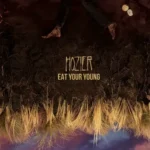By Sara Falluji
On October 25th, 2024, Ashley Frangipane, known better as Halsey, released their fifth studio album “The Great Impersonator.”
Halsey began her music career in 2012, but did not release their first EP, Room 93, until 2014. A year later, they debuted their first studio album, BADLANDS, which stood out as an alt-pop classic. It gained particular popularity across online scenes (such as Tumblr), for painting a vivid internal world of Halsey’s psyche. Two years later, Halsey released her sophomore album hopeless fountain kingdom, an album with lyrics paralleling the tracks off BADLANDS, such as references to a ‘kingdom’—later revealed to be the hopeless fountain kingdom—in the BADLANDS track “Castle.” In both BADLANDS and hopeless fountain kingdom, Halsey plays in the confines of a liminal space—in the former, her own psyche, and in the latter, the place between heaven and hell—with stories of love being captured in these constructed localities (Halsey, 2017). Compared with BADLANDS, though, hopeless fountain kingdom had more distinct pop radio hits like “Bad at Love” and “Eyes Closed.”
In January 2020, she released Manic, where she explored different genres and collaborated with various artists to express the “complex aspects” of her personality. This genre differentiation can be seen in tracks like “Ashley,” where Halsey drew emo influence for her vocals, versus songs like “Finally // beautiful stranger,” which are distinctly country-pop. Only a year after Manic was the release of If I Can’t Have Love, I Want Power, an album intended to express a “visceral” tension while exploring themes of “pregnancy, gender identity, [and] body horror” (NME, 2023). This album is charged with atypical song structures and dominated by the rock and alternative genres, with very little pop influence woven within it, demonstrating the darker and angrier experiences Halsey was having.
Three years after this horror masterpiece, Halsey began teasing singles for The Great Impersonator. On June 4, she posted a snippet of a new single, “The End,” captioned “long story short, i’m Lucky to be alive. short story long, i wrote an album” (Halsey, 2024).
“it begins with The End,” Halsey wrote.
As she promoted the singles leading up to the release, she posted images impersonating the artists who influenced her musical journey, linking those artists to the particular album tracks they influenced. Halsey advertised different vinyl variants of The Great Impersonator with different photoshoot themes inspired by the styles of the 1970s, ‘80s, ‘90s, and 2000s. She framed this album under the original question of what she, and her artwork, would be like if she debuted in any of these other decades. However, at its core this album is about an emotional, existential journey through chronic illness.
Halsey opens with “Only Living Girl in LA,” a sharp rejection of the past elements that have made her songs radio hits. Instead of catchy beats and a standard pop song structure, “Only Living Girl in LA” is a long track which opens only with acoustic guitar, the occasional background riff, and Halsey’s soft voice. The song swells and recedes, with drums fading in, until the bridge—where the drum line and bass are intense, almost punishing. Her vocals remain ethereal throughout the tension. The six minute track, inspired by Marilyn Monroe, explores fame and Halsey’s experience feeling like she has to impersonate herself. From there, Halsey transitions into a 90s pop-rock hit with “Ego,” following a similar theme of anxiety and hesitance towards fame.
“Dog Years,” drawing artistic inspiration from PJ Harvey and a poem Halsey wrote in 2022 about the passing of her dog, is about “begging to be let into heaven” as a relief from suffering, despite not being a “good girl.”
You know a mercy kill is what I seek, I didn’t ask to live, but dying’s up to me.
– ”Dog Years”
Driving the narrative of The Great Impersonator are Halsey’s “Letter to God” tracks, from 1974, 1983, and 1998. Starting with “Letter to God (1974)”, which follows “Dog Years,” Halsey ruminates on her childhood and pleas to God, in the refrain: “please God, I wanna be sick, I don’t wanna hurt so get it over with quick / please God, I wanna be loved, I don’t wanna be somebody that they wanna get rid of.” Compared to her later Letters, Halsey’s voice sounds almost drowned out, quiet and reminiscent. The distinctive piano introduction is accompanied by faded out voices of people speaking, creating a slow-motion flurry of sound. Halsey begins singing the first line of the verse, before she trickles off, only returning when the piano and other voices have disappeared. Alone with herself, her harmonies, and distant ambience, Halsey continues to stop and restart as the voices behind her appear and disappear. This constant musical tension creates the anxiety that underlies this song, presenting it as a particularly vulnerable confession Halsey is making while not entirely alone, but nevertheless lonely.
This is followed by Halsey’s “Panic Attack” and “The End,” both of which are the center points of the album. “Panic Attack,” a country-pop track that initially seems quite cliche—“is it love or a panic attack?”—but is sobered by direct callbacks to Halsey’s medical illnesses—“I had to call the doctor, left a note on his machine.” From here, the album shifts sharply into ruminations on Halsey’s physical illness.
When I met you, I said I would never die, but the joke was always mine ’cause I’m racing against time / and I know it’s not the end of the world, but could you pick me up at 8? ‘Cause my treatment starts today
– “The End”
“Letter to God (1983)” reflects this shift. With a pop-y sound accompanied by the background noise of bustling people, Halsey reminisces on her child self’s desire to be sick in order to gain love, commiserating “because I never would have said it if I knew I’d have to wait until the moment I was happy, then it all disintegrates.” She then pleads to be healthy. The song ends with applause, both presenting a juxtaposition of her performance experience and her internally vulnerability, while also demonstrating how her illness freezes her in her musical artwork. The applause is almost mocking, as is the upbeat sound to the song, as if to show Halsey everything that she risks losing. Mirroring the first Letter’s imagery of Halsey being alone amidst background noise, this track shows Halsey clutching onto her secret, even in a crowded room.
The Great Impersonator continues with several singles building upon each other in rapid succession, including two of her pre-release singles “I Never Loved You” and “Lonely Is the Muse”—before the climactic track “Life of the Spider (Draft)”.
“Life of the Spider (Draft)” is Halsey’s most emotional song, visceral in a way her past tracks have arguably not been since “Sorry,” her piano-led lament from “hopeless fountain kingdom.” Her voice has a slight echo, as if it were a voice memo taken in an empty room, and the track is stripped from everything except her voice and the piano. With the piano chord progressions being relatively bare, and her voice laden with raw emotion, this song positions the listener as a close voyeur into a mental breakdown, like watching a silent scene in a movie, where all the hopelessness is telegraphed in what is left unsaid. “Life of the Spider (Draft),” through its titular extended metaphor, is about Halsey’s struggle with her own emotional health and her romantic relationship as she combats her chronic illness and the abandonment that has accompanied her struggles. In her painful, screaming second chorus, Halsey says “I should be getting better, but I’m only getting worse.” She rhetorically asks “God, how could I even think of choosing here to die? ‘Cause then I’m just a problem that you have to take outside.”
“Life of the Spider (Draft)” then leads into the concluding tracks of the album: “Hurt Feelings,” inspired by BADLANDS; “Lucky,” a cover honoring Britney Spears; “Letter to God (1998),” opening with a dialogue with her son and ending with her calling God sick and saying she’s both loved (at last) and terrified; and The Great Impersonator, where in a callback to her first track, she preemptively anticipates her death, imagining her tombstone marked here lies the great impersonator.
Please, God, oh, you’ve gotta be sick, why do you make it hurt, and why’s it over so quick? / Please, God, I’m finally loved, I finally found somebody I don’t wanna get rid of .
– “Letter to God (1998)”, Halsey
Throughout my life, Halsey’s music has been a source of solidarity and comfort for me. My middle school years were punctuated by streaming “Gasoline” and “Young God” off of BADLANDS. hopeless fountain kingdom” is a place of nostalgia for me, as is Manic—released during quarantine years. And most significantly in my life, amidst mental health battles in high school and to this day, If I Can’t Have Love, I Want Power felt like the sole place in the music scene where I could find anything to ward off the intrinsic loneliness of quiet trauma.
As Halsey archived their Instagram and started promoting “The End,” I watched in apprehensive excitement. A few weeks after the single released, I began to come to terms with the fact that I likely had a chronic physical disability. As soon as I first heard it, “Life of the Spider (Draft)” consumed me, skyrocketing to the top of my on repeat Spotify playlist (where it remains now). Halsey’s latest masterpiece articulates the interconnectedness of physical and mental struggle, and the small pockets of hope and grief and love amidst it, in a way that I have spent a lifetime trying to put into words.
I have a difficult time determining what Halsey’s best work is, but The Great Impersonator is an undeniable masterpiece of dissociative fame, grieving motherhood, and an existential exploration of chronic illness as a lens that colors one’s relationships, history, and connection with themselves.
And if I ever try to leave behind my body (If I ever try), well, at least I know it was nеver mine, it was never mine.
– “Only Living Girl in LA”



